Royal Air Force Bishopscourt or more simply RAF Bishopscourt is a former Royal Air Force airfield, radar control and reporting station located on the south east coast of Northern Ireland, approximately 5.8 miles (9.3 km) from Downpatrick, County Down, Northern Ireland and 24.7 miles (39.8 km) from Belfast, Northern Ireland. A Marconi AMES Type 84 radar was located on the airfield and an AMES Type 80 radar was located at Killard Point, Ballyhornan. An AMES Type 93 mobile radar was also located on the airfield from 1989 until the station closed.

ROTOR was an elaborate air defence radar system built by the British Government in the early 1950s to counter possible attack by Soviet bombers. To get it operational as quickly as possible, it was initially made up primarily of WWII-era systems, notably the original Chain Home radars for the early warning role, and the AMES Type 7 for plotting and interception control. Data from these stations was sent to a network of control stations, mostly built underground, using an extensive telephone and telex network.
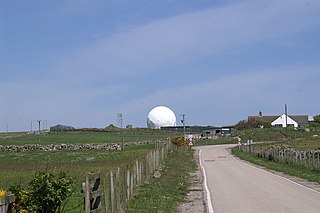
Royal Air Force Buchan or more simply RAF Buchan is a former Royal Air Force station near Peterhead in Aberdeenshire, Scotland.

Remote Radar Head Benbecula or RRH Benbecula, is an air defence radar station operated by the Royal Air Force. It is located at Cleitreabhal a'Deas, 17 kilometres (11 mi) from Lochmaddy on the isle of North Uist in the Outer Hebrides of Scotland.
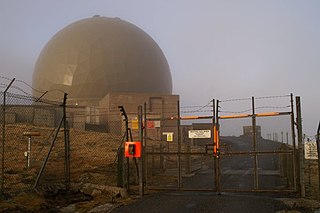
Remote Radar Head Saxa Vord or RRH Saxa Vord, is a Royal Air Force radar station located on the island of Unst, the most northern of the Shetland Islands in Scotland. As of July 2019 it is once more a fully operational radar station, after closure in 2006. The station's motto Praemoneo de Periculis reflects its role. RAF Saxa Vord is further north than Saint Petersburg in Russia, and on the same latitude as Anchorage, Alaska. The station was named after Saxa Vord, which is the highest hill on Unst at 935 ft (285 m). It holds the unofficial British record for wind speed, which in 1992 was recorded at 197 mph (317 km/h) — just before the measuring equipment blew away.
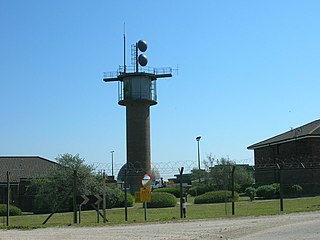
RemoteRadarHeadStaxton Wold or RRH Staxton Wold is an air defence radar station operated by the Royal Air Force, located near Scarborough in North Yorkshire, England. As it has been a radar site continuously since 1939, it has a claim to be the oldest working radar station in the world.

RAF Stenigot is a former Second World War radar station situated at Stenigot, near Donington on Bain, Lincolnshire.

Royal Air Force Ash or more simply RAF Ash was a Royal Air Force underground control centre and radar station situated near the village of Woodnesborough, Kent, England.
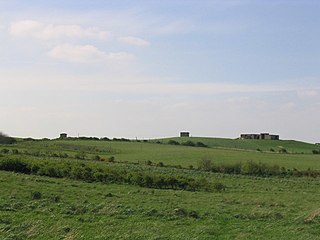
Royal Air Force Bempton or more simply RAF Bempton is a former Royal Air Force station situated at Bempton in the East Riding of Yorkshire, England, 6 miles (10 km) north of Bridlington. During the Second World War it was established as a radar station, becoming part of the Chain Home Low (CHL) network.

Royal Air Force Goldsborough or more simply RAF Goldsborough is a former Royal Air Force station located in North Yorkshire, England.

RAF Ventnor is a former Royal Air Force radar station located 0.7 miles (1.1 km) north east of Ventnor on the Isle of Wight, England. It was initially constructed in 1937 as part of a World War II coastal defence programme codenamed Chain Home. The site played an important role during the Second World War, providing early warnings of incoming bomber attacks carried out by the Luftwaffe.
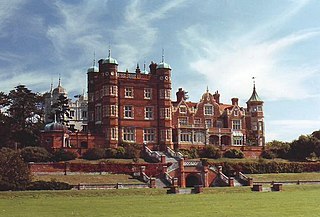
Royal Air Force Bawdsey or more simply RAF Bawdsey is a former Royal Air Force station situated on the eastern coast in Suffolk, England. Also known as Bawdsey Research Station (BRS), the first Chain Home radar station was built there, characterized by eight tall masts, four for transmitting and four for receiving. When the research group moved to Dundee in September 1939, the radar station was left active under the name RAF Bawdsey. The site later hosted a Bristol Bloodhound surface-to-air missile station until 1990, with the station closing in 1991.
RAF Beachy Head is a former Royal Air Force radar station and one of the many Chain Home Low radar stations, being situated near Beachy Head and Eastbourne in East Sussex, England. It featured a Type 16 radar that was monitored from RAF Kenley.

Remote Radar Head Buchan or RRH Buchan is an air defence radar station operated by the Royal Air Force. It is located at Stirling Hill, 3.2 kilometres (2.0 mi) south of Peterhead on the Aberdeenshire coast of North East Scotland.
Royal Air Force Danby Beacon or more simply RAF Danby Beacon was an early warning radar Royal Air Force station that formed part of the Chain Home network of radar stations built by the Royal Air Force immediately prior to the Second World War.
No. 60 Group RAF was a group of the British Royal Air Force. It was established in 1940 with the headquarters in Leighton Buzzard, as part of RAF Fighter Command. It controlled the electronic Air defence radar network across Britain. It was responsible for all civilian and service personnel involved in the operation, maintenance and calibration of the Chain Home radar stations.
Royal Air Force Swingate Down or more simply RAF Swingate Down is a former Royal Air Force Chain Home Low radar station operational during the Second World War located north of Dover, Kent, England.

Bent Rigg Radar Station,, was a radar site located at Bent Rigg, 0.6 miles (1 km) south of Ravenscar, North Yorkshire, England. Several radar stations had been located in the Ravenscar area from 1938, but a more permanent site was built at Bent Rigg in 1941, which was crewed by technicians and other staff from the Royal Air Force. Bent Rigg, and the wider location around Ravenscar, was deemed "attractive" for the siting of long-range finding equipment. It was originally part of the Coastal Defence/Chain Home Low (CD/CHL) system, designed to detect shipping. Later, it was upgraded with more powerful equipment as part of the Chain Home Extra Low (CHEL). The last recorded use of the station was in September 1944, and it is believed that the site closed soon afterwards.

Cresswell radar station, was a Chain Home Low Second World War radar site at Cresswell, in Northumberland, England. The radar site was south of the village of Cresswell on the road towards Lynemouth and each site occupied a different side of the road. The site was opened by early 1940 and was staffed by Royal Air Force personnel from No. 60 Group, who were accommodated at Lynemouth instead of being billeted at the radar site. Cresswell radar site was known to be poorly located as it did not have enough of a significant elevation above sea level to provide sufficient warning of approaching aircraft. Since closure c. 1945, both sites have been demolished and nothing remains of either site.















